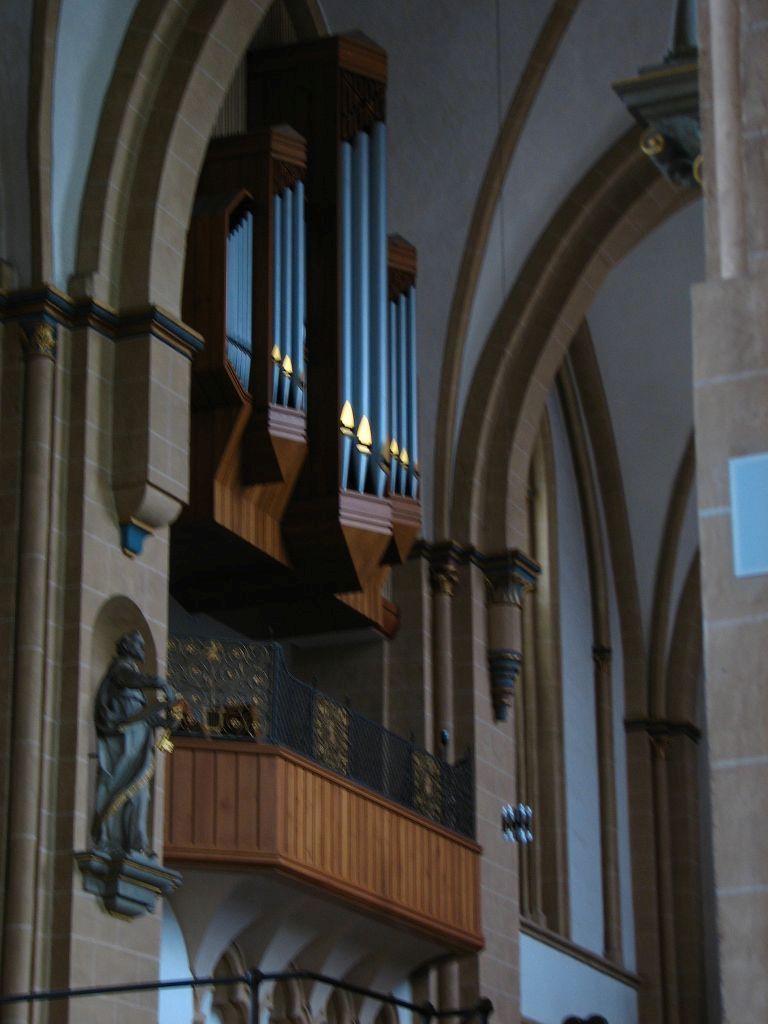Complete description of the selected organ

Photo: Arno Bekers
Paderborn, Deutschland (Nordrhein-Westfalen) - Hohen Domkirche Sankt Liborius, Chororgel
Municipal: Paderborn
Region:Westfalen
Address: Domplatz 3, 33098, Paderborn
Website: https://www.dom-paderborn.de/
Description nr.: 2002848.
Built by: Siegfried Sauer (1979)
The organ contains older material: Pipes and console from 1952 by Anton Feith
Technical data
Specification
Hauptwerk (C-g'''): Rohrbordun 16', Prinzipal 8', Dulzflöte 8', Gedackt 8', Octave 4', Koppelflöte 4', Nasat 2 2/3', Octave 2', Mixtur 5-6 fach (1 1/3'), Trompete 8', Zink 4', Tremulant.
Positiv (C-g'''): Geigenprinzipal 8', Salizional 8', Rohrquintade 8', Singend Prinzipal 4', Labialklarinette 4', Nachthorn 2', Viola Piccola 2', Quinte 1 1/3', Sesquialter 2 fach, Scharff 4 fach (1'), Rankett 16', Krummhorn 8', Trichterdulzian 8' - 2005, Tremulant.
Schwellwerk (C-g'''): Italienisch Prinzipal 8', Hohlflöte 8', Gemshorn 8', Zartgeige 8' - Celeste, Prästant 4', Blockflöte 4', Salizet 4', Quintflöte 2 2/3', Schwiegel 2', Sifflöte 1', Rauschpfeife 4 fach (2 2/3'), Terzzimbel 3 fach (2/5'), Dulzian 16', Trompette Harmonique 8', Oboe 8' - 2005, Vox Humana 8' - 2005, Schalmey 4', Tremulant.
Hochdruckwerk (C-g'''): Bassclarinette 16' - 2005; 190 mm, Waldhorn 8' - 2005; 400 mm.
Pedalwerk (C-f'): Prinzipal 16', Subbass 16', Gedacktbass 16', Quintbass 10 2/3', Octavbass 8', Gemshorn 8', Cello Pomposo 4', Piffaro 2 fach (4' + 2'), Hintersatz 4 fach (4'), Posaune 16', Trompete 8', Tremulant.

Photo: Arno Bekers
Paderborn, Deutschland (Nordrhein-Westfalen) - Hohen Domkirche Sankt Liborius, Chororgel
Municipal: Paderborn
Region:Westfalen
Address: Domplatz 3, 33098, Paderborn
Website: https://www.dom-paderborn.de/
Description nr.: 2002848.
Built by: Siegfried Sauer (1979)
The organ contains older material: Pipes and console from 1952 by Anton Feith
| Year | Builder | Opus | Activity | 1979 | Siegfried Sauer | new organ | 2005 | Siegfried Sauer | restoration and enlargement |
- After the Second World War, the Domkirche in Paderborn was rebuilt. A temporary organ was installed in 1948. This was expanded to 25 stops in 1950 and placed on the high choir. In 1952 Anton Feith rebuilt the instrument, which now had 42 stops. In 1979, Siegfried Sauer built a new organ on the same location. Much of the pipework was taken over from the previous instrument, as was Feith's console from 1952.
- In 2005 the organ was overhauled by Siegfried Sauer. The disposition was modified. The Positiv was expanded with a Trichterdulzian from the main organ. The Schwellwerk received two stops from the Krypta organ, namely an Oboe and a Vox Humana. Finally, a new Hochdruckwerk with two stops has been installed as the fourth keyboard.
Technical data
| Number of stops per division | |
| - Hauptwerk | 11 |
| - Positiv | 13 |
| - Schwellwerk | 17 |
| - Hochdruckwerk | 2 |
| - Pedalwerk | 11 |
| Total number of stops | 54 |
| Key action | Electropneumatic |
| Stop action | Electropneumatic |
| Windchest(s) | Cone chests |
| Pitch | a' = 440 Hz |
| Temperament | Equal temperament |
| Wind pressure | 80 mm (Positiv), 82 mm (Hauptwerk) en 85 mm (Schwellwerk en Pedal) |
Specification
Hauptwerk (C-g'''): Rohrbordun 16', Prinzipal 8', Dulzflöte 8', Gedackt 8', Octave 4', Koppelflöte 4', Nasat 2 2/3', Octave 2', Mixtur 5-6 fach (1 1/3'), Trompete 8', Zink 4', Tremulant.
Positiv (C-g'''): Geigenprinzipal 8', Salizional 8', Rohrquintade 8', Singend Prinzipal 4', Labialklarinette 4', Nachthorn 2', Viola Piccola 2', Quinte 1 1/3', Sesquialter 2 fach, Scharff 4 fach (1'), Rankett 16', Krummhorn 8', Trichterdulzian 8' - 2005, Tremulant.
Schwellwerk (C-g'''): Italienisch Prinzipal 8', Hohlflöte 8', Gemshorn 8', Zartgeige 8' - Celeste, Prästant 4', Blockflöte 4', Salizet 4', Quintflöte 2 2/3', Schwiegel 2', Sifflöte 1', Rauschpfeife 4 fach (2 2/3'), Terzzimbel 3 fach (2/5'), Dulzian 16', Trompette Harmonique 8', Oboe 8' - 2005, Vox Humana 8' - 2005, Schalmey 4', Tremulant.
Hochdruckwerk (C-g'''): Bassclarinette 16' - 2005; 190 mm, Waldhorn 8' - 2005; 400 mm.
Pedalwerk (C-f'): Prinzipal 16', Subbass 16', Gedacktbass 16', Quintbass 10 2/3', Octavbass 8', Gemshorn 8', Cello Pomposo 4', Piffaro 2 fach (4' + 2'), Hintersatz 4 fach (4'), Posaune 16', Trompete 8', Tremulant.
| Literature |
|
| Links |
https://paderbornerdommusik.de/orgel/ https://www.orgel-owl.de/pb_dom_c.htm |
